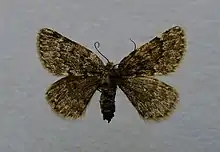Glacies coracina
Glacies coracina, the black mountain moth, is a moth of the family Geometridae. The species was first described by Eugenius Johann Christoph Esper in 1805. It is found in northern Europe and in mountainous areas from Norway, Sweden, Finland, Poland and northern Russia to Japan. It is also present in Great Britain, Romania and Bulgaria and in the Alps. It is found at elevations of up to 3,000 meters.
| Glacies coracina | |
|---|---|
 | |
| Scientific classification | |
| Kingdom: | |
| Phylum: | |
| Class: | |
| Order: | |
| Family: | |
| Genus: | |
| Species: | G. coracina |
| Binomial name | |
| Glacies coracina (Esper, 1805) | |
| Synonyms | |
| |
The wingspan is 18–24 mm. Adults are on wing from June to August and are day active. There is one generation per year.
The larva feeds on the leaves of various low-growing plants, including Betula nana and Empetrum nigrum.
Subspecies
- Glacies coracina bureschi Varga, 1975 (Bulgaria)
- Glacies coracina coracina (Esper, 1805)
- Glacies coracina dioszeghyi (Schmidt, 1930) (Hungary)
- Glacies coracina lappona (Wehrli, 1921)
- Glacies coracina pseudonoricana (Wehrli, 1921)
- Glacies coracina transiens (Wehrli, 1921)
- Glacies coracina tundranoides (Malicky, 1966)
External links
| Wikimedia Commons has media related to Glacies coracina. |
- Kimber, Ian. "70.289 BF1965 Black Mountain Moth Glacies coracina (Esper, 1805)". UKMoths. Retrieved 30 June 2019.
- Fauna Europaea
- Lepiforum e.V.
- Schmetterlinge-Deutschlands.de
This article is issued from Wikipedia. The text is licensed under Creative Commons - Attribution - Sharealike. Additional terms may apply for the media files.